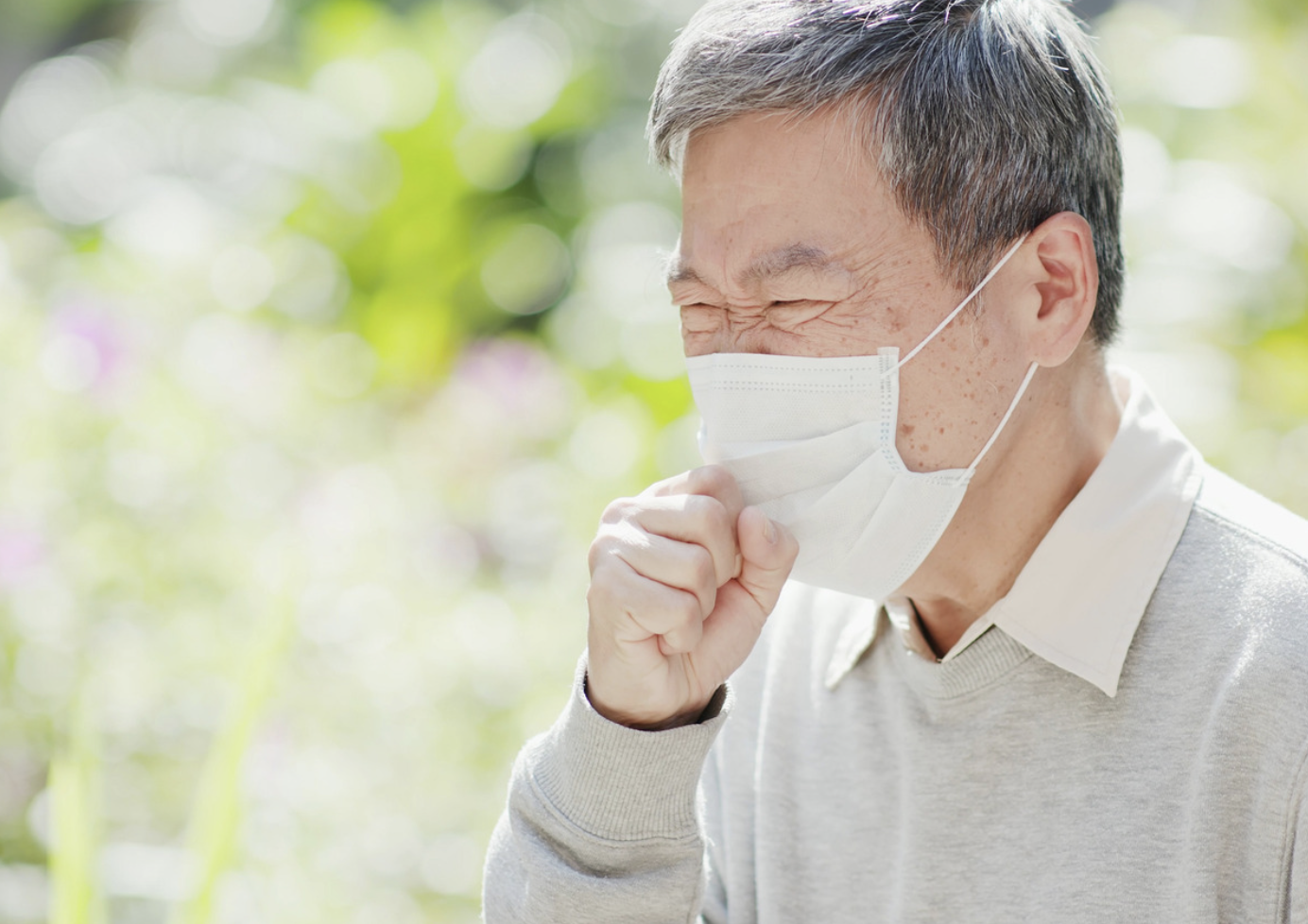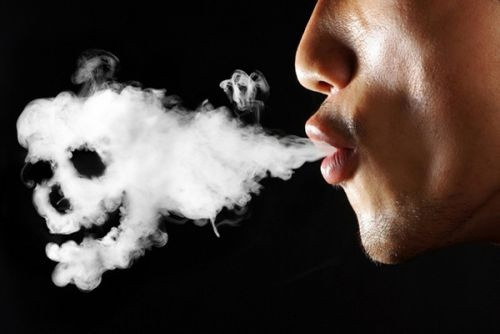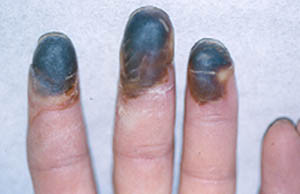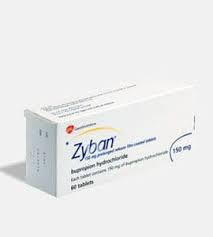Definisi
Emfisema adalah salah satu tipe Penyakit Paru Obstruktif Kronis (PPOK) berupa kerusakan pada jaringan penyusun paru sehingga menyebabkan gejala sulit menghembuskan napas (ekspirasi). Pada paru-paru seseorang yang mengalami emfisema, kantung udara (alveolus) mengalami kerusakan sehingga tidak lagi elastis. Alveolus juga bertambah besar, sehingga tubuh sulit untuk mengeluarkan karbon dioksida dari paru ke atmosfer. Karbon dioksida tersebut terperangkap di dalam paru sehingga paru kesulitan mendapatkan oksigen.
Tipe PPOK lainnya adalah bronkitis kronik, yaitu peradangan berkepanjangan pada saluran napas di percabangan tenggorokan. Terkadang, seseorang dengan emfisema juga mengalami bronkitis kronik secara bersamaan. Rokok adalah penyebab utama dari PPOK.
Prevalensi PPOK meningkat seiring dengan bertambahnya usia dan paling sering terjadi pada usia 60 tahun. Laki-laki lebih sering mengalami PPOK dibandingkan perempuan. Penelitian pada tahun 2013 di DKI Jakarta, Banten, dan Jawa Barat menunjukkan sekitar 5,4% perokok mengalami PPOK.
Penyebab
Paparan rokok dan iritan lainnya dapat menyebabkan peradangan pada saluran napas. Sel-sel inflamasi bertujuan untuk mengatasi iritan, namun di saat yang bersamaan menghasilkan enzim yang dapat merusak alveolus, yaitu matrix metalloproteinase. Enzim tersebut dapat mendegradasi elastin, salah satu penyusun alveolus yang menyebabkan alveolus menjadi elastis. Hilangnya elastisitas pada alveolus menyebabkan alveolus dapat mengembang (ketika menarik napas), namun tidak dapat kembali ke ukuran semula untuk mengeluarkan karbon dioksida.
Selain merusak alveolus, proses peradangan juga menyebabkan saluran pernapasan menyempit akibat produksi lendir berlebih.
Faktor Risiko
Faktor risiko yang meningkatkan risiko mengalami emfisema, antara lain:
- Merokok. Emfisema seringkali disebabkan oleh merokok. Risiko mengalami emfisema meningkat seiring dengan meningkatnya jumlah rokok yang dikonsumsi.
- Usia. Walaupun kerusakan paru pada emfisema terjadi secara perlahan, orang yang merokok telah mengalami gejala emfisema sejak usia 40–60 tahun
- Perokok pasif. Perokok pasif atau secondhand smoker adalah istilah yang digunakan untuk menggambarkan orang-orang yang tidak merokok namun terpapar terhadap asam rokok. Terpapar asap rokok dari orang lain juga meningkatkan risiko mengalami emfisema.
- Paparan polusi. Asap kendaraan atau asap pabrik juga meningkatkan risiko emfisema.
- Genetik. Beberapa kondisi genetik tertentu, seperti defisiensi alfa-1 antitripsin dapat menyebabkan seseorang mengalami emfisema.
- Memiliki kondisi medis lain, yang memperberat emfisema, seperti asma.
Gejala
Awalnya, emfisema tidak menyebabkan gejala apapun atau hanya gejala ringan. Seiring dengan bertambahnya kerusakan alveolus, gejala yang dirasakan akan semakin berat. Gejala tersebut antara lain:
- Sering batuk dan suara terdengar mengi (bunyi ngik ngik)
- Batuk berdahak
- Sesak napas, terutama ketika sedang melakukan aktivitas
- Dada terasa berat
Sebagian besar orang yang mengalami emfisema lebih sering mengalami infeksi saluran napas, seperti common cold. Pada kondisi yang lebih berat, emfisema juga dapat menyebabkan penurunan berat badan, otot terasa lemas, dan pembengkakan pada tungkai.
Diagnosis
Diagnosis dari emfisema mengacu pada kriteria diagnosis dari PPOK secara keseluruhan. Dokter akan menanyakan mengenai keluhan utama, gejala yang dialami, faktor risiko, dan paparan terhadap iritan tertentu. Diagnosis dari PPOK membutuhkan pemeriksaan penunjang berupa spirometri. Jika hasil spirometri menunjukkan Anda mengalami PPOK, tahap selanjutnya adalah menentukan klasifikasi PPOK yang dialami berdasarkan skor kuesioner COPD Assessment Test (CAT) dan Modified Medical Research Council (mMRM). Klasifikasi ini akan menentukan rencana pengobatan yang Anda terima.
Pemeriksaan penunjang yang dilakukan, antara lain:
- Spirometri. Spirometri berfungsi untuk mengidentifikasi obstruksi atau hambatan pada saluran napas. Anda akan diminta untuk melakukan beberapa prosedur atau manuver, seperti menarik napas dalam dan mengeluarkannya secepat mungkin dalam 1 menit. Pemeriksaan spirometri dilakukan dengan mengukur volume yang berhasil dikeluarkan pada manuver tertentu.
- Arus puncak ekspirasi. Pemeriksaan ini dilakukan jika spirometri tidak dapat dilakukan atau pemeriksaan perlu dilakukan di IGD. Prinsip pemeriksaan ini mirip dengan spirometri.
- Saturasi oksigen. Pemeriksaan ini dilakukan untuk mengukur kadar oksigen dalam darah.
- Analisis gas darah. Pemeriksaan ini dilakukan untuk mengukur kadar oksigen dan karbon dioksida dalam darah.
- Rontgen dada. Foto toraks atau rontgen dada berfungsi untuk menyingkirkan penyebab lain yang dapat menyebabkan gejala yang mirip dengan emfisema.
Tata Laksana
Tidak ada pengobatan yang dapat mengobati emfisema secara keseluruhan. Obat-obatan yang diberikan berfungsi untuk mengontrol gejala, memperlambat progresi penyakit, dan meningkatkan kualitas hidup agar Anda dapat tetap melakukan aktivitas fisik. Beberapa pengobatan juga dapat diberikan jika komplikasi dari emfisema telah terjadi. Pengobatan tersebut antara lain:
- Obat-obatan, seperti:
- Bronkodilator. Obat-obatan bronkodilator berfungsi untuk merelaksasikan otot pada saluran pernapasan sehingga memperluas diameter saluran napas. Pada beberapa kasus, sediaan bronkodilator juga mengandung kortikosteroid yang dapat membantu meredakan peradangan. Jenis obat-obatan lainnya akan bergantung pada klasifikasi penyakit Anda.
- Vaksin. Vaksin influenza dan pneumonia direkomendasikan untuk penderita emfisema. Infeksi saluran napas yang berat lebih sering terjadi pada pasien emfisema.
- Antibiotik. Jika Anda mengalami infeksi bakteri sekunder, dokter dapat memberikan antibiotik untuk mengendalikan infeksi tersebut.
- Terapi oksigen. Jika Anda mengalami serangan PPOK (eksaserbasi), kadar oksigen dalam darah Anda dapat turun sehingga memerlukan terapi oksigen. Terapi oksigen dapat membantu mempermudah proses pernapasan Anda.
- Rehabilitasi. Program rehabilitasi dapat dilakukan pada pasien untuk meningkatkan kualitas hidup. Program ini dapat meliputi program olahraga, manajemen gejala, konseling nutrisi, dan psikososial.
- Operasi dilakukan sebagai pilihan pengobatan terakhir pada pasien yang tidak merespon terhadap pengobatan atau mengalami komplikasi.
Perubahan gaya hidup merupakan langkah penting yang harus dilakukan oleh pasien emfisema. Perubahan tersebut antara lain:
- Berhenti merokok dan hindari paparan asap rokok. Rokok merupakan penyebab utama dari emfisema, sehingga mengurangi paparan terhadap asap rokok dapat membantu menghentikan progresi penyakit.
- Pola makan. Konsultasikan kepada dokter Anda mengenai makanan yang perlu Anda kurangi untuk mengurangi gejala sesak. Pasien emfisema juga sering mengalami malnutrisi, sehingga asupan nutrisi perlu dipantau dengan baik.
- Beraktivitas fisik secara rutin
Komplikasi
Seseorang dengan emfisema memiliki risiko lebih tinggi untuk terjadinya:
- Paru kolaps (pneumotoraks). Pneumotoraks adalah kolapsnya atau mengempisnya paru. Pneumotoraks terjadi pada 20–60% pasien PPOK dan dapat mengancam nyawa.
- Kor pulmonale adalah jenis gagal jantung yang disebabkan oleh gangguan pada aliran darah.
- Malnutrisi dapat terjadi pada 25-40% pasien emfisema
- Bula. Bula merupakan lubang pada paru yang menghambat paru untuk mengembang secara sempurna. Bula yang besar pada paru dapat pecah dan menyebabkan pneumotoraks.
Pencegahan
Pencegahan utama dari emfisema adalah tidak merokok dan tidak menjadi perokok pasif. Gunakan masker untuk melindungi paru-paru Anda ketika sedang bekerja, terutama jika Anda berada di industri tekstil atau terpapar banyak debu.
Kapan harus ke dokter?
Segera periksakan kondisi Anda ke dokter jika Anda mengalami sesak yang tidak dipicu oleh apapun selama beberapa bulan, terutama jika sesak tersebut mengganggu aktivitas sehari-hari. Jangan berasumsi sesak yang dialami disebabkan oleh penuaan. Diagnosis dini dan penatalaksanaan segera dapat membantu Anda menghindari komplikasi dari emfisema.
Kunjungi IGD jika Anda atau orang terdekat mengalami gejala berikut:
- Merasa sangat sesak hingga tidak bisa menaiki tangga atau berjalan
- Bibir dan kuku terlihat pucat
- Kebingungan dan tidak sepenuhnya sadar
- Dahak yang biasanya putih berubah menjadi kehijauan
- dr Anita Larasati Priyono
Agusti A, Celli BR, Chen R, et al. (2019). Global Initiative for Chronic Obstructive Lung Disease (GOLD) global strategy for the diagnosis, management, and prevention of chronic obstructive pulmonary disease.
Amin M, Yunus F, Antariksa B, et al. (2016). PPOK diagnosis dan penatalaksanaan. Jakarta: Perhimpunan Dokter Paru Indonesia.
Emphysema. (2019). Cleveland Clinic. Available from: https://my.clevelandclinic.org/health/diseases/9370-emphysema
Emphysema. (2021). MedlinePlus. Available from: https://medlineplus.gov/emphysema.html
Mayo Clinic Staff. (2017). Emphysema. MayoClinic. Available from: https://www.mayoclinic.org/diseases-conditions/emphysema/symptoms-causes/syc-20355555











